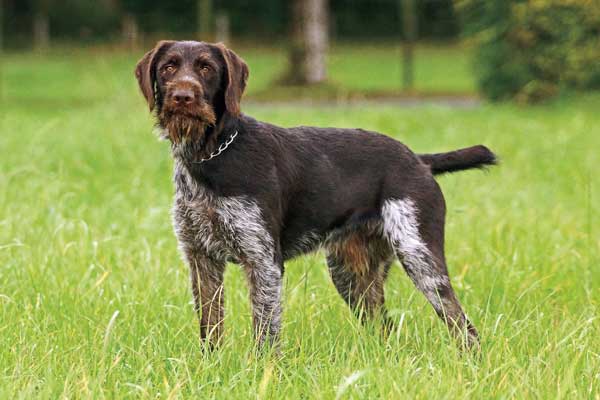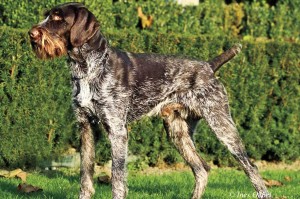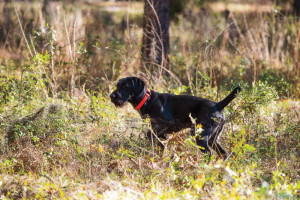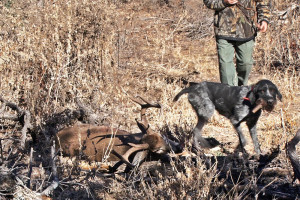 If I arbitrarily threw words like bringselverweiser, toteverbeller and jagd into a conversation, many of you would think I had flipped my bobber, or maybe was trying to pull one over on you vowel-wise. While these words may not have made it into the average sporting dog owner's lexicon, others like Drahthaar have.
If I arbitrarily threw words like bringselverweiser, toteverbeller and jagd into a conversation, many of you would think I had flipped my bobber, or maybe was trying to pull one over on you vowel-wise. While these words may not have made it into the average sporting dog owner's lexicon, others like Drahthaar have.
In a world dominated by well-known breeds like the various retrievers, setters, and pointers, there exists a select group of hardcore bird hunters who seek out and deal exclusively in true German hunting dogs. The aforementioned words carry much more weight in those circles for very good reasons.
One particular individual who immersed his professional dog training life into the German way of doing things is Oklahoma resident Shelby Kervin, the owner of vom Kervinshof Kennels, a facility that deals in authentic Drahthaars and will also facilitate the importation of other German breeds.
Vom Kervinshof Kennels has been around for 25 years. When asked of his beginnings, Kervin recounted his first connection to the German methods of dog breeding and training. "I've been involved with the German system for 30 years, although it all started with police dogs," he said. "I was training German shepherds from the states for law enforcement and they would have to test out to move on. The failure rate was astronomical. Many of the dogs that eventually did test out simply couldn't handle the stress and would get washed out of the system.
"I had some German friends at the time and when I went to visit them they recommended we import our dogs directly from Germany, which is what we started doing. I'd say a significant amount of law enforcement agencies import their dogs from Europe now, which is a testament to the quality of breeding."
Germany lives by a different set of rules than much of the world and holds itself to extremely high standards. Think about firearms, sporting optics, high-end vehicles, etc., and you'll begin to realize much of the best of the best comes out of Germany.
These high standards have been around for decades and resulted in a commitment to creating dog breeds and furthering pedigrees that are simply smarter, harder working, and easier to train than most of the sporting pups out there.
Why Drahthaars?
Kervin speaks fondly of Drahthaars, a stout, deep-in-the-chest breed that is equally comfortable hunting upland birds or waterfowl. "Germans built the Drahthaar around the turn of the century; however, the breed didn't win over the German clubs right away. They called it a mongrel, but it is now probably the No. 1 hunting breed in Europe."

For this purpose, they tapped top bloodlines of pudelpointers, German shorthairs, stichelhaars, and lastly, griffons. It's not hard to understand why the result was originally dubbed a mongrel and a failure, but their commitment to breeding would eventually merge those bloodlines and breed-specific traits into a singular breed capable of handling the various duties they were bred for.
Kervin, who has spent a lifetime around dogs, spoke fondly of Drahthaars; however his tone changed when it came time to discuss his training techniques and desires. "We only take a few dogs each year to train because it's such a specialty," he said. "Our dogs are expected to be able to master multiple tasks and do a lot of things simultaneously."
When pressed to explain his methods of training, he slipped off on a tangent I have heard from top trainers across the country. "We get questions all of the time from folks asking if we can take their dogs for a month or two. Essentially, they are asking if we can quickly fix their dogs. I have to tell them we don't do a little; we finish dogs, which requires a lot of time and effort. Our goal is to create a gentleman's gun dog. It needs to leave us as a companion, friend and a hard worker.
"Through my years of training I've found there seems to be a word that is missing in the dog world and that is management. In most cases dogs aren't going to be hunted seven days a week, so they need to be managed. There seems to be a big misunderstanding with this, but a hunting dog's job goes much further than just hunting. It's necessary to focus on the big picture and that's what we do."
Ready To Buy
When I asked Kervin how a willing customer would go about getting one of his dogs, he explained it's not as simple as putting in an order and waiting for a litter. "Availability is a big issue," he said. "These dogs aren't easy to come by, and we don't sell one-pursuit dogs. We produce about five litters a year out of our kennels and are coming up on our 90th litter of authentic Drahthaars."

"We bring in dogs like the German jagd terrier, which can handle upland game, blood tracking, water work, and specializes in Russian wild boar. We can also bring in pudelpointers, Weimaraners, German shorthairs, dachshunds and German hunting terriers."
If you start to dig into the availability of German breeds in the U.S., you'll come across several breeding clubs. Just like when buying a dog of any breed for hunting or other demanding pursuits, this is a buyer beware situation. True German breeding clubs have to adhere to very strict rules, while other breeders aren't bound to the same strictures.
This can result in a line of Drahthaars that carries the German name but not necessarily the desired pedigree. As with any pup, research into bloodlines is a must as is a full look into clear bills of health.
Blood Trails
It's common for U.S. hunters to question many of the European rules and traditions when it comes to big game. About half the states here allow blood tracking, but it remains illegal in many places due to laws built around concerns of running deer with dogs. There is a movement to turn things around, but it's slow going, which is hard to believe given the popularity of whitetail hunting in particular.
Europe has it right when it comes to blood tracking, however. "Dogs in Germany have to blood track, period," Shelby Kervin explains when discussing various breeds of sporting dogs he deals with that hail from Germany. In typical German fashion, many of the blood-tracking breeds employ methods that go far beyond simply tugging at a leash while sniffing for fresh spoor.

Another is called toteverbeller. "A toteverbeller finds a dead buck or hog or whatever and will sit on it and bark. He will stay with the game animal until you can home in on his location and find him. We have one of the few dogs in the U.S. that can perform that technique."
It's important to note that just because all dogs in Germany are required to blood track, that doesn't mean you can pick any German breed and expect it to find every wounded deer throughout its career.
"Every dog is not a blood-tracking dog," Kervin noted. "A high-drive dog is a poor choice. Blood trailing is like a puzzle to a dog, and any breed that won't exercise patience will have a rough go of it.
"It takes a special dog to be really good at it because when it gets difficult, a slow methodical approach will unravel the pieces and point him on the right path."
For more information on available German breeds, contact Shelby Kervin at (580) 492-5338.
German Sporting Breeds
Shelby Kervin, owner of vom Kervinshof Kennels, specializes in German sporting breeds.
Bringselverweiser
Bringselverweiser (bringsel) game recovery requires the dog to wear a collar with a bringsel. When downed game is found, he puts the bringsel in his mouth and returns to his owner who is then led to the carcass.
All-Purpose Breeds
German-bred dogs like this Drahthaar can tackle upland hunting, waterfowl, and big-game recovery with ease.
True German Breeds
True German-bred dogs like this jagd terrier can perform a litany of tasks due to years of careful breeding and training.
Toteverbeller
A toteverbeller will find a dead deer or other big game animal and sit on the carcass and bay until the owner shows up. German-bred dogs are known for their ability to multi-task between bird hunting and big game duties.






